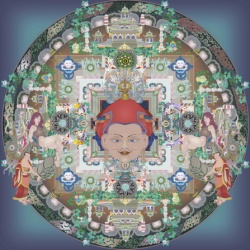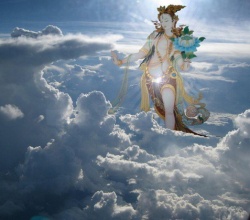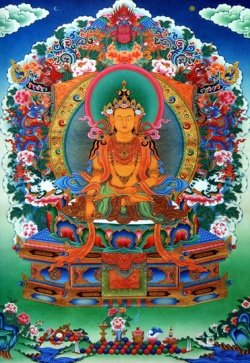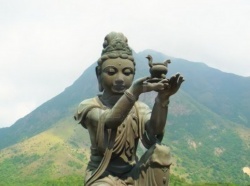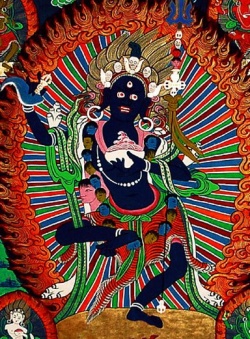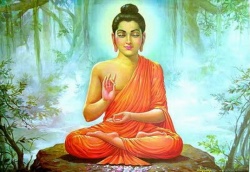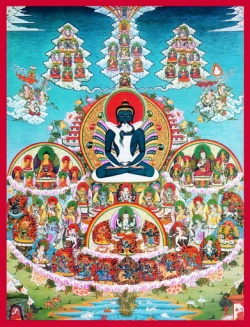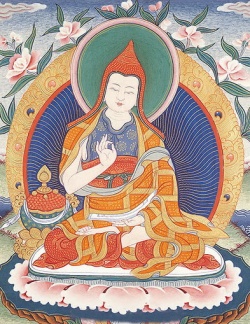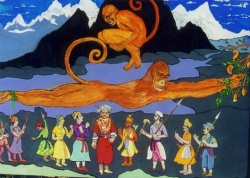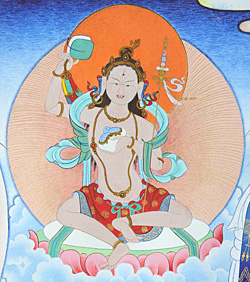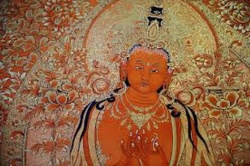Does a table have Buddha-nature?
Mark Siderits
Department of Philosophy, Seoul National University (Emeritus) msideri@ilstu.edu
In “The Way of the Dialetheist: Contradictions in Buddhism,” Yasuo Deguchi, Jay Garfield, and Graham Priest (hereafter DGP) claimed that in certain parts of the Buddhist tradition contradictions are to be accepted as literally true. I shall confine my remarks to the case of Indian Madhyamaka, more specifically the Madhyamaka of the Mūlamadhyamakakārikā of Nāgārjuna (MMK) and its four extant Indian commentaries. About East Asian Buddhism I am not qualified to speak. The DGB thesis might also be thought to apply to Indian Yogācāra and Tathāgatagarbha thought, but those cases would require separate treatment. What I shall claim is that the Madhyamaka of Nāgārjuna and his commentators is best interpreted as rejecting the claim that a contradiction might be true.
More recently DGP seem to have conceded that the interpretation of Madhyamaka that I favor is “orthodox” while their own is “heretical.” 1 So apparently we do not disagree as to which interpretation was more commonly accepted in the tradition. There remains a disagreement as to which is the more philosophically defensible. In defending the view I favor I shall be engaging in a considerable amount of textual exegesis, for which I feel I should apologize in advance. What I seek to show is not only that no Mādhyamika accepted the dialetheist view that contradictory statements can be true, but also that their position makes good philosophical sense when understood within the confines of classical logic. My working assumption (which I believe I share with DGP) is that the Mādhyamikas under discussion were astute philosophers who were well aware of the further implications of the methods they used. Given this assumption, textual exegesis becomes an important component in the investigation of the question at issue between us. I
I begin with some history. DGP bring up the case of the catuṣkoṭi or tetralemma as evidence that certain parts of the Buddhist tradition accept the possibility that contradictory statements might be true (DGP 2008, p. 400). What they have in mind is the fact that in investigating such questions as whether the enlightened person exists after death, not just two but four possibilities are entertained (only to be rejected by the Buddha):
1. The arhat is reborn
2. The arhat is not reborn
3. The arhat is both reborn and not reborn
4. The arhat is neither reborn nor not reborn
That the schema employed here and elsewhere contains the third and fourth koṭis shows, they claim, that there is no presupposition of logical consistency. But the consensus view among scholars of early Buddhism is that the Buddha and his interlocutor understood (3) and (4) to involve parameterization. For instance, (3) says of the arhat that there is one sense in which he is reborn and another sense in which he is not. And although Nāgārjuna’s usual practice when employing the catuṣkoṭi schema is simply to dismiss the third koṭi on the grounds that it is contradictory (thus not invoking parameterization), in XXVII.17–18 and 25–27 he treats the third koṭi as involving the predicate at issue and its negation being taken in different senses.2 This is not, though, why I raise the historical point. What is important about the use of the catuṣkoṭi in early Buddhism is that it introduces a particular rhetorical strategy into Buddhist discourse.
The schema is meant to yield all the possibilities with respect to some question. An air of paradox is generated when the Buddha rejects all four (or, in the case of certain questions, two). The Buddha then typically seeks to dissolve the paradox by claiming that his is a “middle path.” And this is usually said to involve the teaching of dependent origination as it applies to the case of human existence. Now it is not immediately apparent how this invocation of the twelvefold chain (the explanation of the arising of suffering) is supposed to resolve the puzzlement generated by his blanket rejection of all the logical possibilities. But the subsequent tradition understands him to have been tacitly invoking the distinction between conventional truth and ultimate truth. The basic idea is that the question at issue arises only because we take too seriously what is merely a useful fiction. So, for instance, strictly speaking no answer concerning the postmortem fate of the arhat can be correct since strictly speaking there is no such thing, only a causal series of impermanent, impersonal skandhas. There being only an impersonal causal series and no arhat, it cannot be the case that the arhat is reborn, is not reborn, et cetera.
The upshot is that an apparent paradox turns out to be a way of calling our attention to a false presupposition. I submit that this trope goes some way toward explaining the prevalence of seeming paradoxes in the early Prajñāpāramitā literature, and their role in early Madhyamaka. At least many of the contradictions found there can be resolved in much the same way. If we confine our attention to just the first two koṭis in a catuṣkoṭi, and take the predicate at issue to be univocal (so that the parameterization at work in the third and fourth koṭis is not in play), we can say that the rejection of both generates a seeming contradiction: it is both not the case that the arhat is reborn and not the case that the arhat is not reborn. This seems equivalent to the assertion that the arhat both is not reborn and is reborn.
What the two-truths strategy reveals is that there is equivocation involved in the generation of this contradiction. Equivocation is a common means of generating apparent contradictions, as when one says of an old high school friend that they are the same and yet not the same. In that case the ambiguity lies in “the same,” which can mean either numerical or qualitative identity. In the present case it is “not” that is revealed to be ambiguous — namely between the classical “not” of the second koṭi and the illocutionary “not” in the Buddha’s rejection of both koṭis. Once we see that there are two distinct negations in play here, we quickly grasp that the Buddha’s rejection of the second koṭi is not equivalent to the affirmation of the first, and likewise that his rejection of the first is not equivalent to affirmation of the second. The double negation rule does not apply
to cases of mixed negation, since illocutionary negation is commitmentless.3 This rhetorical strategy proved popular and effective in early Buddhism and Abhidharma.
Asserting a contradiction in this way is something of a head-snapper, since it generates a powerful conversational implicature.
It calls on the audience to excavate the presupposition common to all the koṭis and consider the possibility that something widely taken for granted might turn out to be false. The distinction between the two truths facilitates this. When the presupposition can be shown to be conventionally true — a shorthand device that often proves useful in everyday life — then its not being strictly speaking true is more readily entertained. But things look rather different when we move to the Madhyamaka context, since now the presupposition failure is no longer local but global. What Nāgārjuna does repeatedly in the MMK is to show that the presupposition that there are things with intrinsic nature leads to contradiction. To reject the claim that there are things whose nature is intrinsic is to deny that there are any ultimate truths whatever.4 And if we take this to mean that the very idea of ultimate truth is incoherent, then the audience can no longer take solace in the thought that the taken-for-granted presupposition is a mere useful fiction, something that misses important details of the full final picture. One option at this point would be to hold that there is an ultimate truth but that its nature is inexpressible. This would make the false presupposition the idea that the ultimate nature
of reality can be expressed using concepts.
And as DGP are well aware, this leads to a new paradox, the paradox of ineffability. There is, though, an alternative. This would be to embrace the rejection of any sort of ultimate truth, whether expressible or not. It would mean the abandonment of all seeking after the final grand theory of everything. And this is what I suspect Nāgārjuna had in mind. While Nāgārjuna is often portrayed as radically opposed to the core ideas of Abhidharma, there is more actual agreement than one might expect. His discussion of nonself (MMK XVIII), his account of the twelvefold chain of pratītyasamutpāda (MMK XXVI), his arguments against “views” (dṛṣṭi) (MMK XXVII), and his critiques of the theses of Pudgalavāda or Personalism (MMK IX, X, XI, XII, XVII) all sound remarkably like orthodox Abhidharma. He also makes free use of the key Abhidharma idea that composite entities are conceptually constructed and thus not ultimately real. All this suggests that he takes the Buddhist Reductionist strategy of Abhidharma to be useful in leading toward the cessation of suffering.5 The difficulty he sees in Abhidharma is just that it takes there to be things with intrinsic nature when there are not.
It is indeed widely held that Mahāyāna in general merely extends the Abhidharma teaching of the selflessness of person (pudgalanairātmya) to the case of dharmas (dharmanairātmya). My claim is that Madhyamaka’s critique of Abhidharma is not that it gets things hopelessly wrong, just that it does not go far enough. Now, the Abhidharma project is aimed at helping practitioners extirpate all sense of an “I.” Why might belief in the ultimate existence of dharmas with intrinsic nature stand in the way of successful completion of this project? The answer, I submit, is that the 376 Philosophy East & West
Abhidharma path instills in its practitioner a subtle form of self-affirmation that must still be dealt with.
Ridding oneself of the “I”-sense is a daunting task. This is clear from the neverending succession of outraged responses to the Buddha’s denial of the self. And this helps explain the central role that philosophy has played in the Buddhist path. Philosophers are committed to follow the argument wherever it leads. Such a commitment seems necessary if one is successfully to challenge as deeply held a view as that our favorite word “I” does refer to something real. While much Abhidharma doctrine is just an attempt at classifying and codifying the Buddha’s teachings, one can see, in tendencies like Sautrāntika and its conception of the ultimate truth, the emergence of just such a commitment. The difficulty is that when the philosopher attains what they take to be the ultimate truth, they are inclined to pound the table.
And that this gesture reveals a residual “I”-sense may well be hidden from its holder when the ultimate truth in question is that “I” does not designate anything ultimately real. Radical measures are then called for. The Mādhyamika prescribes a dose of emptiness: the ultimate truth is that there is no ultimate truth. The teaching of emptiness was first articulated in a class of texts collectively referred to as the Prajñāpāramitā. Prajñā is the wisdom or insight that is said to be among the six perfections (pāramitā) or virtues one must acquire to become a bodhisattva. In these texts this wisdom is said to consist in the realization that all things are empty. On the present understanding of emptiness, it is the virtue of epistemic humility: that the liberating insight is nothing special.
Many will find this interpretation of emptiness disappointing if true. “Surely,” one is inclined to say, “there is more to the profound and radical teaching of emptiness than a mere corrective to and completion of the Abhidharma path. Surely it must be something of great significance, such as that everything is connected to everything else.” To this reaction I have two responses. The first begins with a point Jay Garfield is fond of making. While we might fear letting go of the notion that there is the ultimate truth (“how things are, anyway”), no one was ever hurt by falling. What hurts is hitting whatever is at the bottom, but if there is no ultimate truth then there is no bottom.
To this point I would now add that falling can be exhilarating — once one knows there is no bottom. So disappointment may not be the appropriate reaction. A second response begins by asking just what one sought and finds missing from the proposed understanding of emptiness. Why the disappointment? I suspect that in many cases the missing ingredient will turn out to be what Mr. Casaubon sought in his quest for “the key to all mythology”: a scheme that makes sense of the totality. And one might want this because it is comforting to know one’s place in the larger picture. If so, then the reaction of disappointment shows there is still work to be done on the project of extirpating the “I”-sense. In MMK XIII.8, Nāgārjuna expands the meaning of “view” (dṛṣṭi) (which usually refers to some theory concerning the reference of “I”) to cover all metaphysical views concerning the ultimate nature of reality. Emptiness, he says, is a useful tool for ridding oneself of such views. But he then calls those for whom emptiness is itself a view “incurable” (asādhya). (It is here that Candrakīrti famously likens emptiness to the purgative that must purge itself in order
to be effective.) The dialetheist interpretation of Madhyamaka attributes to the ultimate reality of emptiness various contradictory properties. The question is whether this move does not undermine the point of emptiness.
II
This is, in any event, how the DGP thesis looks from the perspective afforded by my understanding of Madhyamaka. But this does not constitute a refutation of the thesis. At best all I can hope to have shown is that there is a way of understanding Madhyamaka that avoids attributing to the school the view that there are true contradictions. Why, though, is this to be avoided? To address this question I turn now to textual exegesis, along with some considerations having to do with Madhyamaka methodology. That there are statements in the Madhyamaka corpus having the form of contradictions is not to be disputed. I have so far discussed strategies for explaining away such occurrences. I shall now be looking at evidence bearing on the question whether we should always avail ourselves of such strategies. My hope is that this exegetical work will help bring out the rationale behind Madhyamaka’s deflationary attitude toward truth. I start with evidence concerning the Madhyamaka stance with respect to contradictions as such. I then move on to some specific contradictions attributed to Madhyamaka by DGP.
I mentioned earlier that in MMK XXVII.27, Nāgārjuna (uncharacteristically) treats the third koṭi in the question at issue (whether the series of lives has an end) as involving parameterization. But his treatment of the fourth koṭi in verse 28 reverts to the usual form of blanket rejection: since the third is wrong, and the fourth is the (classical) negation of the third, the fourth likewise cannot be asserted as true. Candrakīrti explains: “Because the object of the negation cannot really be, so the negation is not possible” (pratiṣedhyasya vastuno ‘sambhavāt pratiṣedhasyāpy asambhava). One might wonder about this ready dismissal, since the falsity of p would seem to guarantee the truth of ~p. But what seems to be at work here is the notion, widely shared in classical Indian semantics, that “semantic fitness” (yogyatā) is a condition on the meaningfulness of an utterance. The idea is that a word-string that is syntactically well formed fails to generate cognition of a sentence-meaning if it is in fact impossible for the referents of its component words to stand in the relation they are said to stand in.
This is what Candrakīrti is saying here, and at somewhat greater length in his comments on XXV.15. One is justified in performing the illocutionary negation of p & ~p as well as of ~(p & ~p) because any word-string of the form p & ~p lacks meaning. Just as it is hard to see how the statement “The borogoves were all mimsy” could be true, so on this view one could not say that a contradiction is true (or false, for that matter).
It might be claimed that Mādhyamikas take this stance only with respect to runof- the-mill contradictions, and not with those that arise “at the limit.” So we should look at what DGP have to say about the specific contradictions that they claim Mādhyamikas affirm. There seem to be two such: that emptiness, the ultimate nature of everything, is no nature; and that the ultimate nature of reality/emptiness, which is
unconceptualizable and inexpressible, can be correctly conceptualized and expressed as inexpressible.
DGP cite Candrakīrti’s comments on MMK XV.8, XVII.8, and XXIV.18–19 as cases where a contradiction of the first sort is affirmed as unambiguously expressing the ultimate truth (DGB 2008, p. 402 n. 11). But I can find no trace of this idea in the Prasannapadā (PP) on MMK XV.8, which merely explains why something that existed with intrinsic nature would have to be eternal. There is an argument, at 9a–b and its commentary, for the conclusion that there must be intrinsic nature, but this is put in the mouth of the opponent, and is answered by a refutation in 9c–d and commentary.
As for the PP on MMK XVII.8, this merely expands on Nāgārjuna’s reductio of the Sautrāntika theory that karmic causal continuity is explained by their seeds hypothesis; neither the term svabhāva nor any of its synonyms occurs here. So this does not seem to show that Candrakīrti thinks of emptiness as a nature that is no nature. Perhaps they meant MMK XVIII.8, which they cite in the Introduction (DGP 2008, p. 395). But their translation of this verse is in error. It should not be Everything is real and is not real, both real and not real, neither real nor not real. This is Lord Buddha’s teaching.
But rather
All is real, or all is unreal, all is both real and unreal, all is neither unreal nor real; this is the graded teaching of the Buddha.6
And as all the commentaries make clear, these are four distinct teachings that buddhas make on different occasions to different audiences, utilizing their pedagogical skill and out of compassion. The teaching that “all is real,” for instance, is the assertion that the skandhas, dhātus, and āyatanas (i.e., those things that Ābhidharmikas take to have intrinsic nature) are all ultimately real; it is provided to those who need careful distinctions among concepts in order to make progress. So this verse cannot be taken as evidence that Nāgārjuna claims that reality is paradoxical in nature. All he says here is that a wise teacher will employ different claims about the nature of reality on different occasions.
This leaves the PP on MMK XXIV.18–19.
Here Candrakīrti does call emptiness a property that all dharmas possess by virtue of their originating in dependence on causes and conditions. He does not, however, directly raise the question whether this conflicts with the fact that if nothing arises with intrinsic nature, then there is nothing that can have the nature of being empty or devoid of intrinsic nature. What he does discuss is Nāgārjuna’s claim that emptiness is conceived in dependence on other things. To say that emptiness is like the chariot in this respect, however, of being something that is conceived only in dependence on its parts being arranged in a certain way, is equivalent to saying that emptiness is a conceptual construction and not ultimately real. So we are confronted with something prima facie odd here, although not precisely the contradictory claim that emptiness is a nature that is no nature. To get that from what we are given here we would need the Mādhyamika to say that there are ultimately real dharmas whose nature it is to be empty. Then, since
nothing that is empty can be found at the ultimate level, that emptiness is itself empty (that it is a “dependent concept” or upadāya prajñapti ) would entail that ultimately it is no nature, and we would have a contradiction at the ultimate level.
Now, something like the claim that Madhyamaka is committed to there being ultimately real dharmas as the loci of emptiness does occur in the PP. But it is in the PP on MMK XIII.7. And the claim is made by the opponent, not by Candrakīrti. The opponent wants to know (not unreasonably) how Madhyamaka can claim it is true of all things that they are empty, given that this would mean that ultimately there are no real things. In the background is the standard complaint that emptiness as understood by Madhyamaka is tantamount to metaphysical nihilism, the absurd doctrine that nothing whatever exists. The opponent wishes to force the Mādhyamika to concede this nihilist consequence by demonstrating that the only alternative would have them embracing the contradiction that a nature is no nature.
So DGP are right to see a contradiction in the vicinity of the claim that all things are characterized by emptiness. The question is whether Candrakīrti affirms it as ultimately true. The answer, in a word, is no. All things being empty, emptiness has no locus, and consequently is likened to a garland of sky-flowers. Candrakīrti avoids the contradiction without embracing nihilism by invoking the emptiness of emptiness, making it something that is only conventionally real. (The succeeding verse 8, where Nāgārjuna calls “incurable” one who takes emptiness as a view, is often identified as effectively the first assertion of the emptiness of emptiness.) Here is how this has come about. The realist opponent holds there to be ultimately true statements about ultimately real things. The realist and the Mādhyamika agree that ultimately real things must have intrinsic natures. The Mādhyamika then presents a variety of arguments meant to show that nothing the realist takes to be ultimately real could have an intrinsic nature (e.g., the many arguments of MMK that target various Abhidharma doctrines).
The realist takes this to show that Mādhyamikas hold emptiness to be a universal characteristic of all things. The Mādhyamika does not demur (śūnyatā nāmeti sarvadharmāṇāṃ sāmānyalakṣaṇam ity abhyupagamād [PP, p. 246]). The opponent then takes the Mādhyamika to intend this as an ultimate truth. But since a statement cannot be ultimately true unless there is something ultimately real for it to be about, and nothing is ultimately real unless it has intrinsic nature, this shows there to be a contradiction implicit in their program. When Candrakīrti responds that emptiness depends for its existence on its counterpositive (and thus is itself empty), he is in effect calling emptiness a mere useful device for dispelling the opponent’s illusory belief in a realm of ultimate truth. It is, as Nāgārjuna elsewhere (MMK XVII.31–32) puts it, a magically created being who in turn conjures up other illusions through magic. Emptiness is a universal characteristic of all things the opponent takes to be ultimately real. This being so, there are no such things. That all things are empty is not ultimately true — in the opponent’s sense. It is ultimately true only in the sense in which the Four Noble Truths are “noble”: a realization that is required to attain the cessation of suffering.
DGP claim that since for Madhyamaka there is ultimately no valid distinction between conventional and ultimate truth, any resort to that distinction in order to
defuse the apparent contradiction must fail (DGP 2008, p. 399). The difficulty with this defense lies in its use of “ultimately.” When I have said in the past that for Madhyamaka the ultimate truth is that there is no ultimate truth, by the first occurrence of “ultimate” I intended something like “useful at the final stage in the attainment of cessation.”7 Mādhyamikas seek to help those on the path overcome the realism that hinders them from taking the last step. In doing so they will occasionally enter into the pretense that realism is valid, that the notion of ultimate truth makes sense.
When Candrakīrti says the Mādhyamika agrees that emptiness is a universal characteristic of all dharmas, the verb he uses to express the propositional attitude (abhyupa + √gam) conveys acceptance of something arrived at through discussion. That all dharmas
are empty is not a thesis affirmed as ultimately true (in the realist sense) by the Mādhyamika. As Nāgārjuna says quite clearly (e.g., in Vigrahavyāvartanī 29), Mādhyamikas do not affirm any thesis as ultimately true (in the realist sense).8
The statement that all dharmas are empty is one component of a prasaṅga (reductio) meant to show the error of the opponent’s realist ways. It is what the Mādhyamika thinks the opponent must affirm given their other commitments. The resulting contradiction
— that all things have a nature that is no nature — nicely expresses the Madhyamaka strategy for imploding the realist’s notional world. It is not something Mādhyamikas would themselves independently assert as a correct characterization of the nature of things. All they will say is that one should not assert such things. The negation here is of the commitmentless illocutionary variety.
DGP respond by calling “patently desperate” this way of avoiding attributing to the Mādhyamika the independent assertion of a paradox. I disagree. Of course DGP are right that the Prajñāpāramitā literature contains many instances of the claim that all things are empty. Just what the authors of these sūtras intended by this I would not venture to say. But at least in the hands of Mādhyamikas this claim is perhaps best seen not as a proposition but as a provocation — an intervention justified entirely by its success. This comes out quite clearly in the commentaries on verse 11 of MMK XXII, the investigation of the Tathāgata. In the preceding verses of this chapter, Nāgārjuna has sought to refute the ultimate existence of the Tathāgata (the Buddha), culminating in the claim in verse 10 that the Tathāgata is (like all persons) empty. Next we get, in verse 11:
“It is empty” is not to be said, nor “It is non-empty,” nor that it is both, nor that it is neither;
(“empty”) is said only for the sake of instruction.
Candrakīrti explains that none of these can be asserted as ultimately true because nowhere is intrinsic nature to be found. He adds that each may, however, be said in a specific context for the specific purpose of instructing a particular audience. He then gives instances in which each of the four assertions could be said to be true conventionally. So Candrakīrti is on record as denying that “All things are empty” is universally valid. It is not ultimately true, since no statement could be ultimately true. And it is not warrantedly assertible in some contexts, since its assertion in those contexts would not be conducive to liberation.
That Mādhyamikas are known to say Mark Siderits 381
frequently that all things are empty is just a function of the fact that their Ābhidharmika interlocutors typically need just this last final push to attain liberation. In his comments on this verse, Bhāviveka considers the following objection: when Mādhyamikas assert that we should not make any of these four possible claims about the ultimate nature of reality, they are guilty of an inconsistency. For they say that the ultimate nature of reality cannot be described in any of the four possible ways, and yet this would seem to be a claim about the ultimate nature of reality. This objection clearly invokes the paradox of ineffability, to which we shall turn in a moment, but it also has some bearing on the question whether Madhyamaka asserts that emptiness is a nature that is no nature.
Bhāviveka’s response is that there is no more fault here than there is in the case of someone who, wishing to prevent sound, utters the sound “Quiet!” He is here echoing Nāgārjuna, who in Vigrahavyāvartanī 28 responded
similarly to the objection that at least the statement that all things are empty must be real and so have intrinsic nature. That one must make a sound in order to prevent sound is no bar to the efficacy of the utterance. And it is in terms of its efficacy,
not its correspondence to the nature of reality, that the utterance is to be judged. Of course “Quiet!” is a command, not a statement, and so it could be said that questions of its truth simply do not arise. But to say that “All things are empty” is at best conventionally true is to say that its appropriateness is to be judged in terms of its efficacy in the context of utterance. Like “Quiet!” the intention behind its utterance is to bring about the cessation of something, in this case hypostatization (prapañca). To take it as describing the nature of reality and so leading to paradox may be to miss the point.
Finally, Nāgārjuna does not, as DGP claim, assert that all things are empty in MMK XXIV.19. What he says is that no non-empty dharma is to be found. One could convert this into the assertion that all things are empty only if one took there to be real dharmas with determinate natures — precisely the point at issue. III
DGP claim there is another way to show that Madhyamaka affirms a contradiction, one that goes by way of the paradox of ineffability (DGP 2008, p. 400). The ultimate nature of reality is said to be inexpressible because any characterization of its nature must employ concepts, and all conceptualization involves falsification of the nature of reality that it seeks to express. But the ultimate nature of reality is, after all, expressible, since one can say at least this much about it. So the way that things ultimately are both is and is not inexpressible.
Now the claim that all conceptualization involves falsifying superimposition of mere mental constructions on reality is one that is found in many Mahāyāna texts. But this is, I submit, a characteristically Yogācāra claim, and not one that Mādhyamikas embrace. We can perhaps see why Yogācārins would embrace it when we reflect on the underlying idea of veridicality at work here. The claim is that no proposition expressible
in language can veridically represent the nature of reality because it depends on language. Presumably this entailment holds because language can represent reality only by abstracting away from the concrete details of its nature. But then one must wonder what veridical representation might possibly be like. It begins to look as though nothing short of reality itself could meet the requirement in play.
This poses no challenge for Yogācāra given their idealism. For Yogācāra, perceptions are inherently veridical because they are both non-conceptual in nature and also not distinct from the reality they represent. (Yogācārins are, after all, idealists.) But for anyone not prepared to subscribe to an idealist metaphysics, the understanding of veridicality at work in this argument will appear suspect. One might still claim, though, that Madhyamaka affirms an inexpressible ultimate, perhaps relying on the sorts of considerations that led T.R.V. Murti to a similar conclusion.9 Then, since such an affirmation leads straight to the paradox of ineffability, it might be said that the most charitable reading of Madhyamaka has them dialetheistically affirming the resulting contradiction. There is, however, considerable evidence against this interpretation. Candrakīrti, for instance, dismisses out of hand the Yogācāra attempt to defend their doctrine of the svalakṣaṇa against the criticism that there can be no characteristic (lakṣaṇa) without a thing characterized. When the Yogācāra claims that the svalakṣaṇa transcends the characteristic-characterized distinction due to its being ineffable (avācyatā), Candrakīrti replies that since ineffability would mean the absence of both characteristic and characterized, there could then be no svalakṣaṇa.10
Bhāviveka also seeks to demonstrate the inadequacies of the Yogācāra position by, for example, pointing out that if they wish to claim that the svalakṣaṇa is inexpressible (anabhilāpya), they will be ill equipped to deny the existence of an equally inexpressible self.11 What he has in mind here is the Pudgalavāda (Personalist) thesis that while the person (pudgala) is ultimately real, its relation to the other ultimate reals is inexpressible. Since Yogācārins and Mādhyamikas agree in rejecting Pudgalavāda, this constitutes a difficulty for Yogācāra. But we might add that the Yogācārin is going to be equally hard put to distance their view from the Advaita Vedānta affirmation of a self that is non-distinct from Brahman and so equally inexpressible.
Likewise, when the Yogācārin claims that their trisvabhāva account of emptiness avoids nihilism because conceptual superimposition is on an ultimately real locus that is beyond concepts and so inexpressible, Bhāviveka replies that their reason is contradicted (hetoś cāpi viruddhatā). By this he means that they have run afoul of the paradox of ineffability.12 Of course we expect Mādhyamikas to use contradictions as prasaṅgas in arguing against the views of their opponents, since they take their opponents to hold that no contradiction is true. This need not mean that they themselves would not affirm what for the opponent is an unwelcome consequence. But in the present case this would amount to extreme bad faith. For on the DGP reading, Madhyamaka stands so close to Yogācāra that one would expect Bhāviveka to use this simply as an opportunity to share the insight that some contradictions are true. DGP are of course correct to point out that the notion of an inexpressible ultimate is affirmed in many Mahāyāna texts (DGP 2008, p. 400). And they are no doubt equally correct to connect that stance with an important distinction between the conceptually mediated grasp of the nature of reality that one may attain through philosophical practice, and a more direct grasp of its nature supposedly acquired through meditation.
Yogācāra, for instance, is quite explicit on the point that since those who are not yet fully enlightened must rely on the crutch of conceptualization, the content of the buddhas’ cognition of reality must escape us. This is, however, open to the perfectly banal interpretation that the distinction involved is no more than that between expert knowledge of the biology of the blueberry plant and knowledge of what blueberries taste like.13 The botanist who has never tasted blueberries and is, moreover, color-blind is probably not very good at telling blueberry Pop-Tarts from the other flavors. And just as the gustatorily disadvantaged botanist lacks certain abilities, so the aspirant whose progress on the path to nirvāṇa has not progressed beyond the stage of philosophical theory, while possessing ample knowledge of the knowing-that variety, will lack crucial bits of know-how. They may, for instance, know that there is nothing to which “I” refers, yet not know how to stop acting on the assumption that there is an important difference between “mine” and “yours.” The defilements are, after all, said to be deeply ingrained habits the unravelling of which will take considerable effort.
If “the ultimate” is taken to mean not how things finally are but how one finally attains liberation, then “the inexpressible ultimate” might just be the achievement of a set of practices that banish existential suffering. It is difficult to see how a paradox could result from the mere fact that know-how of this kind requires more than the relevant propositional knowledge.
Still there are Madhyamaka texts that seem to attribute to buddhas certain sorts of insights that cannot be expressed using the concepts of mere worldlings. We can easily see how such claims might have arisen in a climate of intense competition for adherents to one’s lineage. But if these claims are not to be taken seriously and literally, how are we to interpret them? The difficulty for the anti-realist Mādhyamika is that if there is no such thing as the nature of mind-independent reality, it is not clear how buddhas could be deemed to be authoritative by virtue of having cognitions that correctly grasp the ultimate nature of things. But there is a way around this difficulty. One might say that the special epistemic status of enlightened ones comes not from their grasping how things ultimately are, but from their having overcome all sources of error about how things are. Bhāviveka says just this. He says that buddhas see by a kind of non-seeing, due to their rejecting innumerable wrong conceptions by means of faultless inference conforming to authority.14 And, he adds, [The nature of things] is cognized non-conceptually, and is entirely inexpressible, because of the fact that nothing is really arisen, as was said before in the refutation of arising. (5.94)
The point here is a subtle one that is easily overlooked: it is that the ultimate nature of reality is something that is inexpressible and only cognizable non-conceptually because there is no such thing as the ultimate nature of reality. The negative prefixes in “inexpressible” (anabhilāpya) and “non-conceptual” (nirvikalpaka) are to be read in the style of the commitmentless prasajya-pratiṣedha. The cognition of the ultimate 384 Philosophy East & West
nature of things — their all being empty of intrinsic nature — is non-conceptual because, there being nothing to cognize, no cognition arises. To dispel the false imaginings of a dream world is not to cognize how things are; it is just to desist from erroneously cognizing things. We are not here bumping up against the limits of language, just being nudged in the direction of a different way forward. IV
I began with my deflationary understanding of the soteriological significance of emptiness.
On this reading, Madhyamaka quietism is aimed at correcting the fault of table-
pounding, a subtle expression of the defilements that naturally results from following the Buddhist Reductionist path. To put a slightly more spiritual spin on this, one might say that the table has Buddha-nature and one should not strike things that have Buddha-nature. But I do not expect this to mollify DGP, who accuse me of enmity toward Buddhism, of being a “false friend.” I might counter that their claim that “reality is itself paradoxical” contains at least a hint of table-pounding. I would prefer to avoid trading charges in this manner, though. My real concern is that opening the dialetheist gates may let in too many styles of table-pounding.
Mādhyamikas were clearly concerned to avoid letting the Pudgalavādins sneak in their preferred contradiction — that the person, while real, is neither identical with nor distinct from the equally real psychophysical elements. Looming much larger on the later Indian scene are the preferred contradictions of Advaita Vedānta. Are DGP prepared to say how we are to choose among true contradictions? If not, are they prepared to affirm that Madhyamaka, Pudgalavāda, and Advaita Vedānta are in some sense equivalent? From DGP’s dialetheist perspective, my deflationary reading looks like a blanket refusal of the exciting and liberating vistas that open up once we abandon classical logic. From my own deflationary perspective, the dialetheist reading looks like the predictable result of just that view of truth that Mādhyamikas are concerned to overthrow — to help us achieve liberation. At this point I must leave it to the reader to judge which vision of the middle path seems the more plausible.
Notes
The following abbreviations are used in the text and Notes: MMK Mūlamadhyamakakārikā of Nāgārjuna
PP Prasannapadā of Candrakīrti, in V (see below)
V Louis de la Vallée Poussin, ed.,
Mūlamadhyamakakārikās (Mādhyamikasūtras) de Nāgārjuna avec la Prasannapdā Commentaire de Candrakīrti
(Osnabrück: Biblio Verlag, 1970).
1 – This characterization of our respective views occurs in remarks made by DGP at a workshop on their 2008 paper, “The Way of the Dialetheist: Contradictions in Buddhism” (published in Philosophy East and West 58, no. 3 [2008]: 395– 402) that was held at Kyoto University on November 29–30, 2011 — remarks that were made in response to an earlier version of their paper. I shall here distinguish between quotations from DGP’s 2008 paper and references to remarks made by DGP in Kyoto, by specifying “DGP 2008” followed by page number (from the Philosophy East and West article) where I refer to claims made in the former.
2 – I disagree with DGP, who deny that the discussion of the limits of saṃsāra in chapter XXVII involves the use of the catuṣkoṭi. As I read the chapter, verses 21–28 examine the question whether the “world” (loka), that is, person, has an end, with verses 21–24 offering refutations of the first and second lemmas (that the person has an end, and that it does not have an end), verses 25–27 giving a refutation of the hypothesis that the person both does and does not have an end, and verse 28 refuting the possibility that the person neither has nor does not have an end. Candrakīrti’s gloss on verse 25 shows that he takes this to involve the third koṭi: yadi hi kasya cid ekadeśasya vināśaḥ syāt, ekadeśasya ca gatyantaragamanaṃ syāt, syāt tadānīm antavāṃś ca loko ‘nantavāṃś ca (V, p. 589).
3 – DGP call “external negation” what I am here calling illocutionary negation. They correctly characterize it as the kind of negation that “denies the truth of a sentence while not implicating either the existence of the subject of the sentence, or its possession of any properties other than that the sentence denied ascribes to it.” This would, however, not make it an instance of paryudāsa, as they assert, but rather prasajya-pratiṣedha.
4 – By “ultimate truth” I shall here mean a statement that correctly represents how things are in a way that is independent of our interests and cognitive limitations — that accurately depicts “how things are anyway.” This is to be distinguished from what I shall call an “ultimately real entity,” even though the Sanskrit expression paramārtha satya can have either of these two different senses. For more on this see the discussion of the two truths by Guy Newland and Tom J. F. Tillemans in their “Introduction to Conventional Truth” in The Cowherds, Moonshadows: Conventional Truth in Buddhist Philosophy (New York: Oxford University Press, 2010), pp. 3–22.
5 – See my Personal Identity and Buddhist Philosophy: Empty Persons (Aldershot, UK: Ashgate, 2003), for this use of the term “Buddhist Reductionism.” 6 – La Vallée Poussin has: sarvaṃ tathyaṃ [na vā tathyaṃ] tathyaṃ cātathyam eva ca / nāivātathyaṃ nāiva tathyam etad buddhānuśāsanaṃ // (V, p. 369). Ye Shaoyong omits the brackets around na vā tathyaṃ, thus confirming the vā and making this a disjunction (Ye Shaoyong 葉少勇, Zhonglunsong: Fancang 386 Philosophy East & West
hanhexiao • Daodu • Yizhu 中论颂: 梵藏 汉合校•导读•译注 [[[Wikipedia:Shanghai|Shanghai]]: Zhong-Xi Shuju Chubanshe, 2008], p. 304). As for DGP’s “teaching” versus “graded teaching,” Candrakīrti explains anuśāsana as a teaching that is given in due order or proper succession in conformity with the pupil’s needs. So this verse does not hint at the assertion of any contradiction. 7 – In point of fact, this is all that Nāgārjuna says about ultimate truth in MMK, at XXIV.10c–d: “without resort to the ultimate, nirvāṇa is not attained” (paramārtham anāgamya nirvāṇaṃ nādhigamyate) (V, 494). 8 – Vigrahavyāvartanī of Nāgārjuna, in P. L. Vaidya, ed., Madhyamakaśāstra of Nāgārjuna (Mūlamadhyamakakārikās) with the Commentary: Prasannapadā by Candrakīrti (Dharbanga: Mithila Institute, 1960).
9 – See T.R.V. Murti, The Central Philosophy of Buddhism (London: George Allen and Unwin, 1955), pp. 135, 139, 140, 142, 151, 158, 160, 207, 212, 218, 228. 10 – atha vocyate, [avācyata]yā siddhir bhaviṣyatīti cen naitad evaṃ / avācyatā hi nāma parasparavibhāgaparijñānābhāve sati bhavati / yatra ca vibhāgaparijñānaṃ nāsti, tatredaṃ lakṣaṇam idaṃ lakṣyam iti viśesataḥ paricchedāsaṃbhave sati dvayor apy abhāva eveti / tasmād avācyatayāpi nāsti siddhiḥ / (V, p. 65). 11 – Karatalaratna, or, The Jewel in Hand: A Logico-philosophical Treatise of the Madhyamaka School, ed. N. Aiyaswami Sastri (Santiniketan: Visva-Bharati, 1949), p. 60.
12 – Madhyamakahṛdayakārikā 5.71. For English translation see Bhāviveka and His Buddhist Opponents: Chapters 4 and 5 of Bhāviveka’s Madhyamakahrdayakārikah with Tarkajvāla Commentary, trans. and ed. with introduction and notes by Malcolm David Eckel (Cambridge, MA: Harvard University Press, 2008), p. 274.
13 – I owe this point to Tom Tillemans.
14 – Madhyamakahṛdayakārikā 5.105. For English translation see Eckel p. 295.



